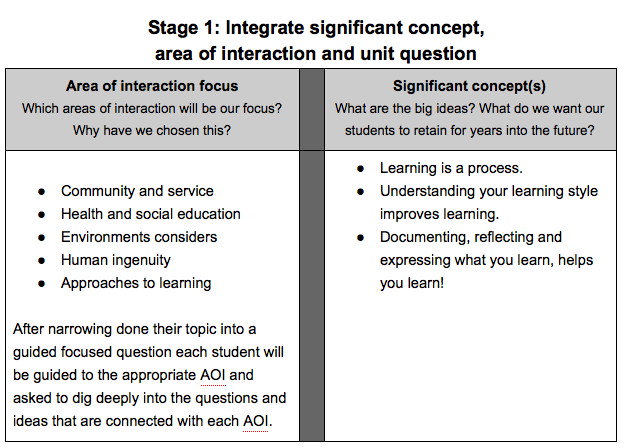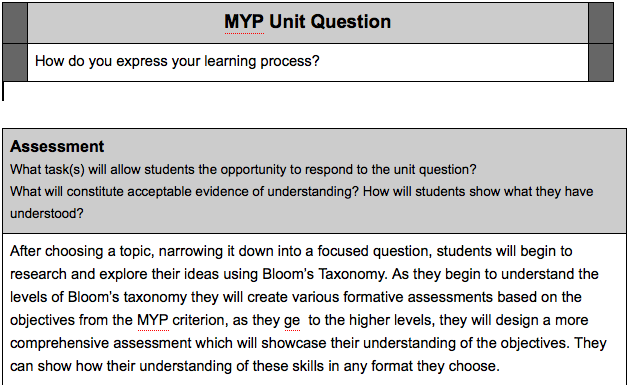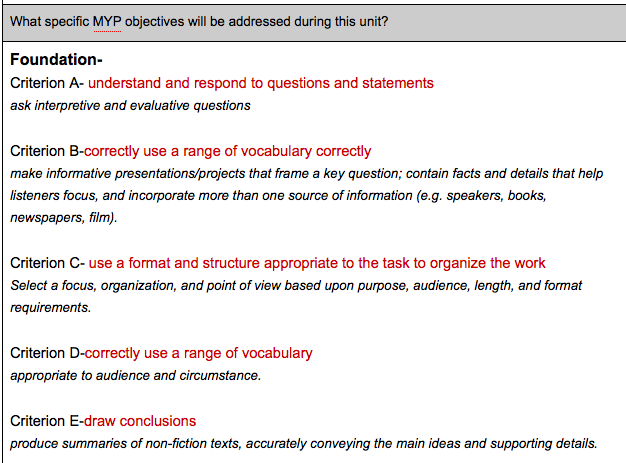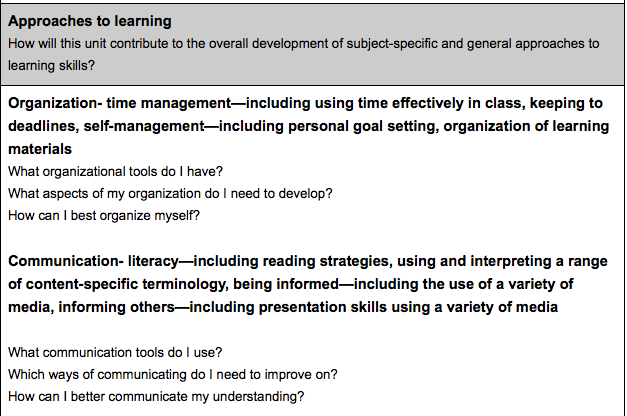If I don’t start this post now, if I wait till it is all clear and ready to go, if I wait till it is all done and wrapped up, if I wait till I settle down and plow through my to-do list then this post will never be written, and to be honest with you I am way too excited about my upcoming unit not to write a preview. Please excuse the slapped together feel of this post. I hope I have spent most of my energy planning what I hope will be one of the best units I have ever planned. It starts tomorrow, runs for ten weeks and looks something like this:
Let me start by saying that while everyone extols the virtues of collaboration, it is not easy for me. I often have loud brash ideas that call for taking strange risks, doing things that I have never done before, and making a lot of things up as I go along. This spontaneous style is not always conducive to a team effort, especially if other teachers prefer to have each lesson planned out and have a clearer idea of how things might actually turn out. I mention this not because these are the types of teachers I am working with, on the contrary, my team has been great- open and resourceful, they are full of great ideas and have not only helped shape this unit, but they have also taken ownership of it and helped it become fundamentally sound. Before I continue, let me introduce my team- first my lovely wife Mairin, who has been a champion Techie. (Yes we work in the same department at school. It is fine, but will be changing next year.) You can find her on Twitter and she blogs here and here. And of course our brave and open-minded colleague Dianne. Who has recently started blogging with her classes here. But enough of the team. What has us so excited? Sit back and enjoy the ride-
I am tried of talking the talking of student based, problem based, inquiry driven pedagogy, only to plan units designed and assessed by me. I am tired of seeing the bored look on student faces as I swear what we are learning is fun and relevant. As a team, we wanted to see if we could give more/most of the responsibility to the students. We wanted to find a way to not only engage them by offering choice in content, but empower them to take control of their learning by letting them also design their own assessment. So what will this look like? We are an MYP school so let me walk you through our unit plan. You can find the unit overview here. But here are some of the details:
(The red print below are the MYP objectives and the italicized text are the standard.
We have chosen to use a combination of Arros and TESOL standards by which to assess student learning. )
Basically we want the kids to choose their content/topic as well as their assessment. They will also choose their AOI once they have a clear guiding question. They will choose a topic of interest, with some guidance they will turn this topic into a focused investigate question and begin to do some research. They will be thinking of ways to describe what they are learning in terms of how they express, share or articulate that learning in terms of the MYP Criterion. We will be using Bloom’s Taxonomy to help move students beyond simple data and knowledge gathering to higher level thinking and problem solving. Sound confusing? Let me walk you through it a bit more.
We have created a Google Doc which we are affectionately calling The Matrix. You can find this document here. (I have tried to make sure it is uneditble, but if for some reason it is editable, PLEASE DO NOT EDIT IT.) This document will serve as a guide, calender and feedback sheet for the entire ten weeks of this unit. It will be home for each project. Each student will copy and paste the contents into a new Goggle Doc which they will and share 1-1 with their teacher. This way we can use this space to help guide student for the duration of the unit. We can add notes, update material, ask questions, as well as share resources and links to help guide students as they work their way up Bloom’s pyramid. Each week they will document what they are doing on The Matrix. They will document how they are meeting each criteria, AOI, ATL, as well as citing sources, and linking to material on their blog. Le’s say for example they create a short skit in which they interview a friend about video games. They will link to the video from their blog on the G-doc and mentioned that they were able to understand and respond to questions (Criterion A), they will also begin to explore how what they are doing/learning is connected to AOI and ATL.
We will start with a survey of skills and interests. This will be in a google doc form, but for now here are the questions:
- What do you know a lot about?
- Is there anything about this you don’t know or would like to know more about?
- Is there anything you know very little about, but would like to learn more about?
- What are some things that you think you might do to help you learn more about this topic?
- What do you know how to do well? How did you learn?
- How do you learn best?
- How do you learn something new?
- Is there anything you do not know how to do that you would like to learn?
- What are some things that you think will help you learn how to do this?
- What are some topics you think you are interested in investigating for this unit?
- How will show what you are learning?
- What sources/resources do you think you will need for this unit?
- In this unit, most of the time you will be working and learning independently.
- What kinds of skills do you think you will need to have/use in order to work and learn successfully on your own?
- What organizational tools do I have
- What aspects of my organization do I need to develop?
- How can I best organize myself?
- Communication
- Time Management
- Organization
- using time effectively in class
- keeping to deadlines
- self-management
- goal setting
- organization of learning materials
What communication tools do I use?
- writing
- blogs
- video
- podcast
- oral presentation
- drawings
- charts
- tables
- drama (role play)
- interviews
Which ways of communicating do I need to improve on?
- writing
- blogs
- video
- podcast
- oral presentation
- drawings
- charts
- tables
- drama (role play)
- interviews
After the survey and a review of the logistics and procedures, we will help students develop an investigative question based on any topic they choose. They will begin to gather knowledge, show comprehension, apply it, go through each week exploring Bloom’s Taxonomy. They will use blog posts, videos, podcast, interviews, surveys, anything they can think of to share their learning, while also showing evidence of the five MYP criterion. We hope to connect them with other classrooms as needs arise, or try to find experts in their fields to help them learn beyond a simple wikipedia search.
Well I got the first ideas down. I hope to blog the entire unit, so if this sounds a bit daunting now, stay tuned. But really it is quite simple: I am calling the kids’ bluff. They always claim that school is boring and irrelevant, well now they can choose to learn about anything they want and be assessed by doing whatever they want. We will push them to think deeply about their topics, but it is up to them to really dig deep and learn. I am beyond excited about getting started. I feel this is a huge step in the right direction to a more inquiry based pedagogy. I think once the wrinkles are ironed out this could be a great model. What do think? Suggestions? Ideas? Potential problems? Questions?





A few years back I worked with a G08 Science class and we talked about the content that needed to be covered and worked to brainstorm how they would like to be assessed on this particular content. Then students chose their particular assessment and then worked with me (as part of the learning process) to write their own rubric based on the assessment chosen and the content expected of the curriculum. It went well but was very time consuming to monitor all individual efforts. It took a long time to guide the rubrics and to make sure that I was also working to accurately cover all the content as well! It was good to work with the EAL teachers closely on this as well as the strategies they used were great for all kids. It was also important to make sure that what the kids chose as their assessment was good enough to reach the top level of their rubric and detailed enough to show content. Good Luck!
Very interesting. It looks a lot like the personal project. Is the big difference that it is specifically focused on the Language B criteria? (That’s the criteria being used, right?)
I’ll be interested to see how kids respond to the reflection required in your survey.
The personal project was the inspiratin, but my kids are 6-8 graders and yes, they are language B students.
Hats off to risk-takers! 🙂
I don’t think there are real problems that might occur – not bigger than in other learning process anyway. Giving students ownership of their learning – from topic to resources and process – is truly empowering.
I am looking forward to seeing how students deal with the challenge!
I love structuring my classroom units to this type of student-directed learning. When I used to teach high school World History I conducted their final research project in a similar manner. It was really fun to think of how to give them enough structure that they weren’t totally lost but enough freedom to learn and figure things out for themselves. It was also really challenging. The first year, I didn’t give enough structure and the quality of the final projects were not fully representative of the student’s abilities. For one thing, the students hadn’t been expected to work that way before (as is likely your case) and no matter how much they want that independence it doesn’t work to thrust it on them all at once. It got better every year as I learned where to spend my time effectively while not burning myself out. By my last year, this was my favorite unit. Students learned to work independently and how to ask questions that would get them to the next step.
Good luck!- I’ll be excited to hear how it progresses.
What happens when you have a student that just wants to be told what to do and what to learn? I have learned this year that many of my students will not work independently on something even if they get to pick it. I don’t know if they are completely confused by the concept of creating their own learning or simply too scared they won’t “do it right”. The group I seem to have the most trouble with in this respect are the overachievers, those students that work hard to succeed. It is like they are more driven by the grade than the learning.
I have been considering how to address this, but it is difficult. I am considering trying to create a process where students can gradually move from teacher directed to self-directed. Maybe different strategies for places on the spectrum? For example, a student can be totally self-directed and not need much prompting, but another student would need to be very directed, to the point of telling them step-by-step what to do.
It will be very interesting to see if you see this behavior in your students. It could be a cultural thing with my students.
I’ve seen that type of reaction before as well and I believe it is a form of learned helplessness. Students are often told: you can learn whatever you want, but then have the door slammed in their faces. Another issue, of course, is that many have never been asked what they are interested in, so they truly don’t know; they know what mom and dad like, they know what their friends like, they know what teachers like, but they have no idea what they are interested in or feel passionate about.
At the project based school I worked at, we often found that sometimes it could take 9-10 weeks to unlearn helplessness and for students to actually take ownership over learning; however, those were high school students, so they had been clubbed and beat more by education than middle school students. You can help a student learn to take back ownership by encouraging and supporting them, but never take over for them, because that reinforces the helplessness. I’m hoping that Jabiz will see some great success from this students as they spread their wings to fly the skies of their own learning.
Jabiz, Dianne and Mairin, it is great to watch these wonderful things happening around the school, yesterday I spent a lot of time with another language group looking at ways to explore a language within an MYP framework. We talked about traditional vocab teaching and I am pleased to say that the group really started to see the value of looking at language teaching in a different way. We have a very enthusiastic crew who are ready to give it a go ( not throwing away the text books yet) but expanding the way that they look at teaching there subject. This is exactly what you are doing here, changing the focus and making it count from a students eyes. I cannot wait to see what the kids come up with, it is always very cool when starting out on a new expedition. Funnily enough a lot of students will have already experienced this within PYP to a certain extent, but the scope here really allows further development. Keep me posted and am happy to pop in at any time.
Jabiz
Bravo for engaging students in determining the outcome of their learning. Constructing units of learning around enquiry is a great way to involve the kids. Blooms taxonomy is rather a linear approach but it is one that is very central to most formal enquiry processes. Your unit of work makes a lot of sense. Further reading includes Think Inq process by Lane Clark Associates, this offers an eight stage model that guides inquiry. Another related planning tool is the Understanding by Design template that hihglighs backward by design planning.
You negotiate with the kids the final learning outcome and then work backwards to the essential questions and key content necessary to get to the goal.
We are in GCSE mode here so we are in some ways driven by exam content in the Middle Years. However things are changing’ Good luck “ga yau” with all you do.
J Mason HONG KONG
Sounds very cool, but also like a ton of logistical work on the teacher’s end (in terms of monitoring, helping find resources, etc.). I do think it’s a great think to attempt, however. I’m a big fan of truly customized learning and this seems to empower students in the process.
Jabiz,
Awesomeness! I was lucky this year moving back into the classroom, because one of my courses is Speech & Debate. I thought to myself — perfect! A performance based elective course with no written curriculum to speak of. A blank slate; a clean canvas; the stuff of dreams for an adventurous teacher. The funny part was, nobody in the department wanted to teach the course. I didn’t even have to fight for it; it was handed to me like the ancient kimchi rediscovered after fermenting a little too long. During the four years I’ve been at KIS, this course has had four different teachers; therefore, the lack of curriculum. No one has taken ownership of this course. The first item on the agenda was to use podcasting to develop an awareness of audience and some passion from the students. Many of the looked baffled and confused when I told them the their show was just that — their show, with their audience. I was going to help with quality control, but the content was totally theirs. Most of the assessment of the podcast was guided by me through conferences after each episode went live, but students were allowed to adjust my initial grades if they could provide reasons why my grading was incorrect. It didn’t happen often, usually during the conference students told me that my assessment was very accurate with what they felt about their performance. This built the necessary reflection and assessment understanding in the students that during one of the other major presentations they were required to design their own rubrics that would be used to assess them; instead of assessing them myself, I then asked them to use their own rubric to self assess and provide examples for each domain. It went very well, but I have high school students and several of them are seniors, so many of them are ready for such self assessment.
I’m looking forward to seeing the final products from your students. Take flight and enjoy the adventure!
Tim
Thanks for the advice and encouragement everyone. Today was day one and we started with the survey and general explanation of what we will be doing. Kids seemed a bit overwhelmed and still bored! How does that happen?
Anyway, I am confident that we will do some pretty great things once we get started. Will keep you posted.
I’d be excited to see how this goes. I’m a firm believer in ownership…
Jabiz,
Wow! I’m tired just reading about this project. As John said earlier, it sounds like a lot of coordination on the teacher’s part.
I’m wondering if you would find more success and less work (in terms of scaffolding) if you started with a student inquiry project that could be completed in one day and then worked up to bigger projects. (Or maybe you’ve been doing this). Curiosity, which drives inquiry, is a muscle that needs to be exercised if you want it to work at full capacity.
In any case, I’m sure the students appreciate a change of pace. (Unless your students are like the girl in my class who asked if we could, “just do worksheet packets”) Keep us posted!
Jabiz, please forgive me if my words sound harsh – they’re not intended that way. When I look at the above and I look at the Google doc – my first thoughts are that it’s boring and dry. All the possibilities have been sucked out by the clinical writing.
If I was in Middle School, all that language sounds so “schooly”. I would compartmentalise my life into stuff I was interested in and passionate about, or had fun with at home – and then there would be the stuff that I’d have to do for school. There’s no bridge in that syllabus for the learners to grok that you’re trying to make a connection.
My humble suggestions (based on my Grade7/8 music teacher who was the most inspiring teacher I ever had):
– Talk like a normal person (I’m sure you do to your class, but why not make the language in the syllabus and Google Doc do that) – I understand the need for a certain style, but does it serve that purpose in this context?
– Give some real life examples. It’s too open ended – they don’t have any idea what you think is acceptable. They may be playing too safe because of their prior experience of school. Do a show & tell. Ask them to bring in things they’re passionate about from home. Tell them you’re interested in their lives. Do they like playing video games? Listening to music? Art? Sports? Movies? Engage them in something concrete from their lives by getting them to bring in things that they do.
– When they bring in their stuff, ask them to talk for 5-7 mins about it. Tell them it’s not graded. Give them freedom to express why it’s important to them. It’s an opportunity for them to tell their peers and you why it’s worthwhile learning about why their particular interest is awesome. If it’s World of Warcraft, then they have to explain to your class why it’s awesome. etc. etc. Call it a talk about awesomeness or whatever. Talk in their language.
– If that all works out, then maybe you’ll have a class of kids that you understand better in terms of what engages them outside of school. Concrete things that you can ponder and shape the inquiry around, rather than a nebulous clinical concept that the kids don’t really get.
Does that makes sense?
Best,
– Ian
Jabiz,
Good luck with this unit! I will be following your writings to see how it goes…
I am library media specialist at an IB school and as I am collaborating with my MYP colleagues I am developing my understanding of the way we “inquire” and “research”. My BIG THOUGHT at the moment is “The questions you ask, determine the answers you get”. In my search to find ways to help students develop “good” research questions and develop lines of inquiry, I have been developing a document very close to yours, with Bloom’s taxonomy as the basis.
QUESTION: Have you tried to match up the MYP command terms with the six steps in Bloom’s taxonomy? (If I do this I think I will be more likely to speak the same language as my MYP colleagues…. ) Have you found someone else who has? Any other suggested readings to help me on my way?
May your enthusiasm lift your students!
Gretha
Pingback: Letting Go « brianbennett.org/blog
Pingback: Letting Go - nodes